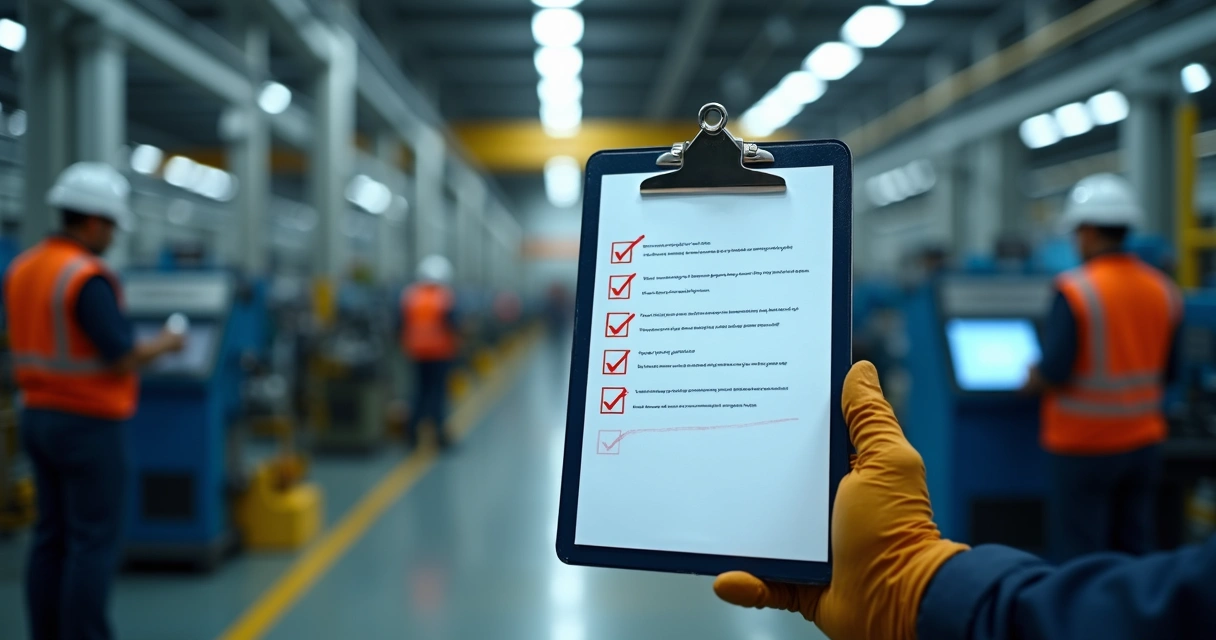Lista de comprobación práctica para evitar el retrabajo durante las paradas industriales

Industrial shutdowns—those planned downtime periods that keep equipment running for months on end—can cause as many headaches as they solve. Sometimes, no matter how much you prepare, things slip through the cracks, tasks get missed, work has to be redone. Rework in these moments means wasted labor, extended downtime, frustration, and quite a lot of money lost along the way. I’ve seen teams celebrate wrapping up a shutdown, only to realize hours later that something critical was overlooked—a simple checklist could have spared everyone the trouble.
Recent studies, for instance, have shown that more than 50% of companies still rely on manual spreadsheets and notes to plan and execute shutdowns, which makes errors more likely. Add in unqualified labor—cited by 38% of professionals as a hurdle—and it’s no wonder why up to half the companies surveyed face overruns of at least 5%. This isn’t a criticism; it’s a reality.
Having worked beside plant managers, planners, and maintenance crews for years, I know first-hand: simple, effective checklists turn chaos into order. And when these lists are paired with solutions like Prelix, which helps spot root causes of failures and generates instant, actionable reports, that order gets stronger and more resilient over time.
Why rework is such a big deal
It might sound like a minor inconvenience, but the ripple effects are huge. Every repeated task cuts into scheduled uptime, burns extra manpower, chips away at morale, and chips away at profit. According to recent findings, high rates of rework in maintenance can spike operational costs and lower overall output. And the loss is not just about money. It’s also about opportunity—every hour spent redoing a job is an hour where innovation stalls.
Rework is expensive, demoralizing, and often completely preventable.
- Redone jobs may overlap with upcoming tasks, causing scheduling headaches.
- Pressure to make up lost time can lead to rushed or unsafe behavior.
- Rework buries teams under paperwork and manual logs.
Sophisticated tools like Prelix can help, but without an at-the-ready checklist, the odds of rework spiral higher.
Checklist fundamentals: what should always be included
A checklist isn’t magic, but it’s powerful. It’s not just a list; it’s a way to make sure nothing big or small escapes notice. And, while every industry and plant is different, there are foundational items you always want to include.
- Detailed scope definition: Be specific. Ban phrases like “fix as needed.” Instead, state: “Replace bearing on pump #3 and check alignment.”
- Clear task ownership: Assign each task to someone, not “the team.” Use names and contact info—ambiguity slows everyone down.
- Pre-shutdown equipment checks: Inspect tools, safety gear, and parts before shutting down anything. Surprises kill momentum.
- Step-by-step instructions: Even seasoned techs forget things. Explicit, repeatable steps help—especially in high-pressure shutdowns.
- Integrated safety checks: Insert safety at every stage, not just the end. Sometimes, this comes naturally. Sometimes, it doesn’t.
- Intermediate sign-offs: Don’t leave final approval until the end. Have quality, safety, and engineering review as they go.
- Data collection points: Know what data matters. Record numbers, times, conditions, anomalies, as these help systems like Prelix track patterns and failures over time.
- Post-completion review: No job is truly done until a post-job review checks the finished work. Did the repair hold? Was the root cause of failure addressed?
 How to build and use your checklist
How to build and use your checklist
Now, not every plant is the same. Some are more complex, others less so. What matters most is adapting your checklist to fit the reality you deal with daily. Maybe you’ve used online templates, or maybe all you have is a lined notebook and a ballpoint pen. Doesn’t matter—the thinking behind the list is what counts.
Start with the end in mind
Ask, “What outcome do we want from this shutdown?” Not just “get it restarted”—make it about reliability, safety, and compliance. A tool like Prelix can actually help clarify this, using analytics to identify recurring failures or safety gaps that deserve extra checks.
Break big goals into micro-tasks
People forget steps. It happens. So break down all big jobs into granular actions. Instead of “service cooling tower,” list each valve, fan, bearing, and electrical check separately. The granularity is tedious, yes, but it’s how you catch what others miss.
Map out dependencies
Some jobs can’t start until something else is finished. Map these dependencies, perhaps with a diagram. Prelix automatically generates these, but if you’re still on paper, create a simple flowchart so no one waits around unnecessarily.
Bring everyone in early
Loop in operations, engineering, safety, and quality representatives as you build the checklist. Surprising as it sounds, someone will always notice a missed step that you won’t. People see things differently—and that’s a good thing.
Test and revise continuously
Use your checklist on a small job and ask for honest feedback. Adjust items, clarify as needed, and add anything obvious in hindsight. Repeat until the checklist “flows” on its own, even for those who weren’t part of its writing.
Integrating technology: turning lists into insights
Over 50% of companies still rely heavily on manual systems (link). This may work for some, but as operations scale up, the need for smarter integration grows. Technology isn’t about replacing people—it should make your lists smarter and your reporting sharper. With tools like Prelix, you get real-time root cause diagnosis and compliance-ready reports without manual data entry.
Besides, advanced data and checklist analytics can spotlight recurring mistakes, predict failures, and automate those all-important follow-ups. The result? Less rework, more predictability, and more consistent results.
 Safety, compliance, and the hidden risk of rework
Safety, compliance, and the hidden risk of rework
One overlooked task can cascade into bigger troubles. Unplanned downtime, according to recent reporting, is one of industry’s most expensive headaches. Fortune Global 500 companies can lose 11% of annual revenue to shutdowns—a staggering figure. And costs are up 65% in just two years, fueled by higher supply costs and a shrinking pool of skilled workers. You can’t afford rework. Not on this scale.
Checklists don’t solve all problems, but they do shine a light on the easy-to-forget details—whether they’re related to safety, compliance, or just sound engineering. See something that’s off? Write it down, address it before moving forward. That’s where a tool like Prelix can give you the edge, linking checklists to real-world analytics and tracking every step until completion.
A checklist is a promise—nothing gets missed, no step skipped, no hidden risk ignored.
Conclusion: checklists as your quiet superpower
If I had to sum it up? Most rework in industrial shutdowns isn’t about laziness or lack of care. It’s about missing details, forgotten steps, and unclear communication. Checklists don’t take thinking away; they clear the fog, put the biggest risks front and center, and keep teams focused on what matters most.
And yes, pairing these checklists with smarter tools, like Prelix, helps you get there faster, with fewer surprises and much less rework. Ready to turn shutdown chaos into steady, predictable results? Start building that checklist now—or try Prelix and see how much easier each shutdown can feel.
Preguntas más frecuentes
¿Qué es una lista de control para paradas industriales?
A checklist for industrial shutdowns is a structured set of step-by-step tasks and verifications to guide teams through maintenance, repairs, and inspections. It ensures that nothing is forgotten and helps teams complete shutdowns safely and effectively, minimizing delays and rework.
¿Cómo evitar la repetición de trabajos durante las paradas?
You can avoid rework by starting with a detailed, itemized checklist, assigning clear responsibility, reviewing each step as you go, and gathering input from everyone involved. Also, using tools like Prelix to identify potential root causes and track tasks digitally can help eliminate common sources of error. Regular practice and post-shutdown reviews also make a big difference.
¿Cuáles son los errores más comunes en las reconversiones industriales?
Common mistakes include unclear task definitions, poor communication, relying on memory instead of written lists, missing dependencies, and skipping quality or safety checks. Not involving all stakeholders early and not updating checklists after finding mistakes are also frequent causes of trouble.
¿Por qué utilizar una lista de control en paradas industriales?
A checklist in paradas industriais helps teams work with more predictability and less risk. It keeps everyone on track, reduces the chance of missing steps, and supports better communication. With growing complexity and tighter schedules, checklists help teams avoid costly errors and improve long-term results.
¿Cómo puedo mejorar la planificación de mi parada?
To improve your planning, define your objectives clearly, break work into actionable steps, and involve your entire team. Use historical data to spot common failures. Adopt tools like Prelix to automate reporting and tracking. Always update your checklist after every shutdown—continuous learning makes each event better than the last.
